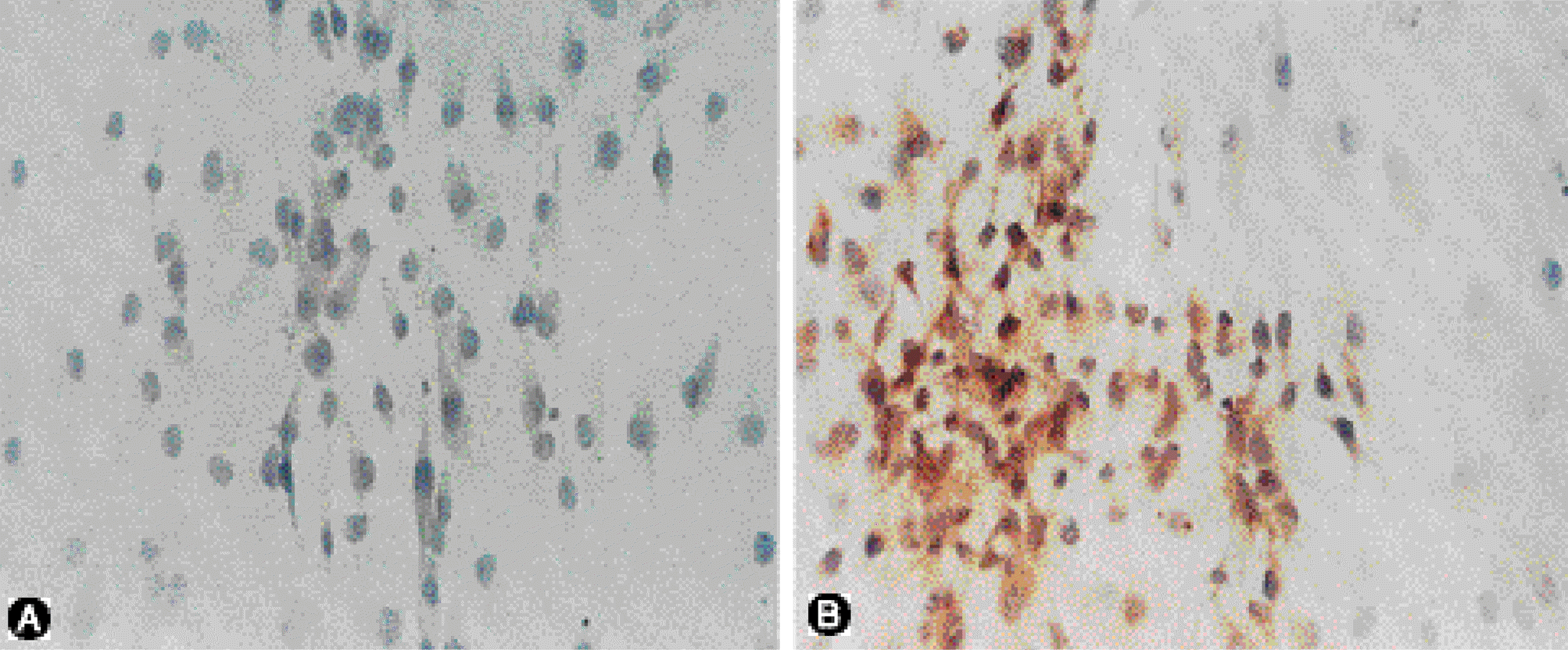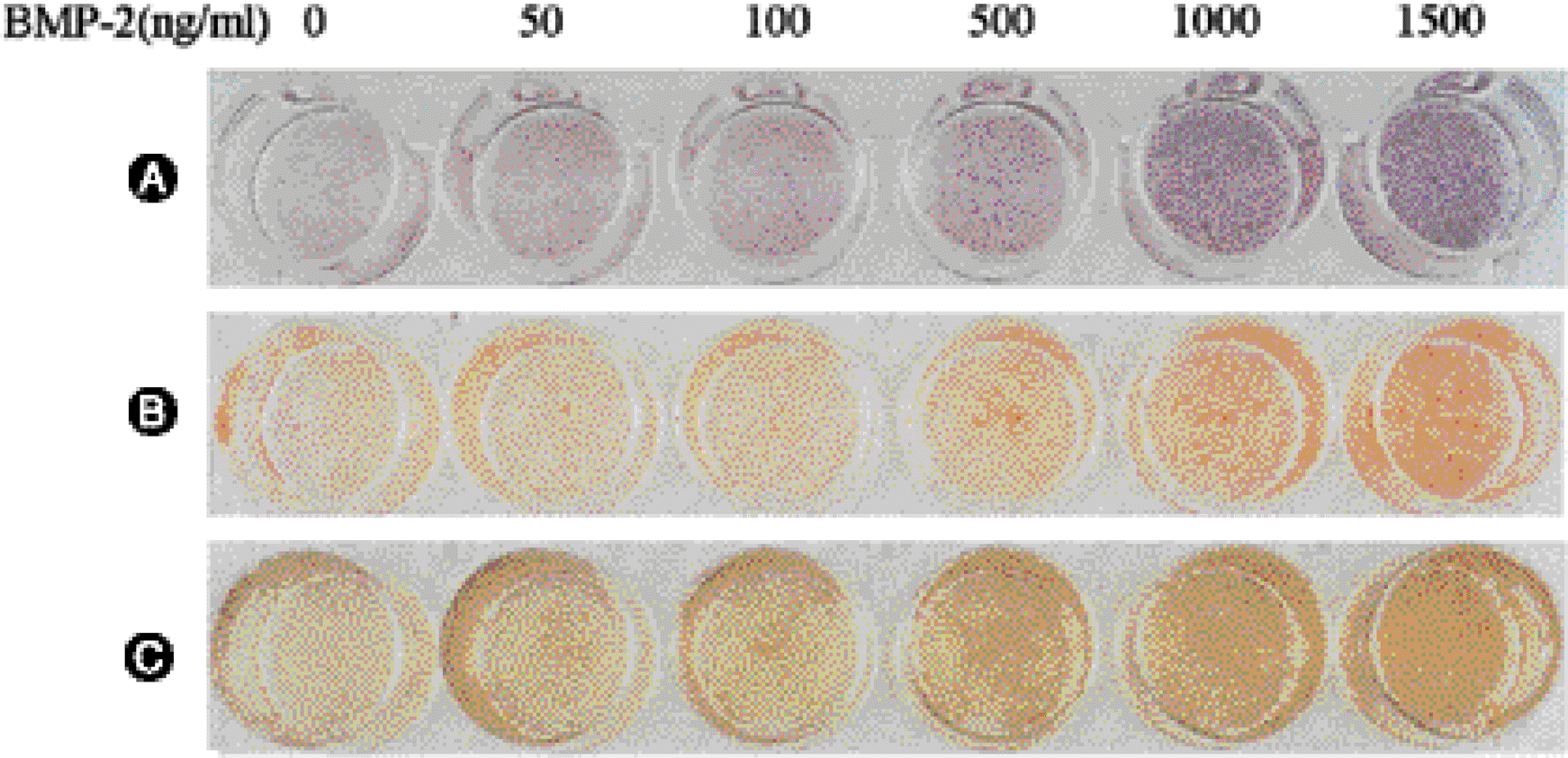Abstract
Objectives
To determine the effect of bone morphogenetic protein- 2 in the osteogenesis of human ligamentum flavum cells and test the feasibility of gene transfer to these cells.
Summary of literature review
Bone morphogenetic protein- 2 (BMP- 2) is known to be an important factor in the differentiation and maintenance of the osteoblastic phenotype. Tissue engineering for osteogenesis in ligamentum flavum by BMP- 2 and gene transfer has not been previously studied.
Materials and Methods
Ligmentum flavum cells were harvested and cultured from surgical patients with spinal stenosis. BMP- 2 was produced by transfecting pcDNA 3.1/Hygro/BMP- 2 into CHO cells using Lipofectamine 2000. A denovirus- lacZ (A d/lacZ) was also produced, and administered with BMP- 2 to cell culture. The expression of lacZ was analyzed by X - gal staining. Bone formation was assessed by alkaline phosphatase, von Kossa, and alizarin Red- S staining, and the expression of osteocalcin was determined immunocytochemically.
Results
Ligamentum flavum cell cultures with A d/lacZ showed marker gene expression. BMP- 2 induced osteogenesis in ligamentum flavum cells as evidenced by alkaline phosphatase, von Kosa, and alizarin Red- S staining. A lso, cell culture with BMP- 2 showed strong positivity with osteocalcin by immunocytochemistry.
REFERENCES
1). Hayashi K, Ishidou Y and Yonemori K. Expression and localization of bone morphogenetic proteins (BMPs) and BMP receptors in ossification of the ligamentum flavum. Bone. 21:23–30. 1997.

2). Hoshi K, Amizuka N, Sakou T, Kurokawa T and Ozawa H. Fibroblasts of spinal ligaments pathologically differ -entiate into chondrocytes induced by recombinant human bone morphogenetic protein-2: morphological examinations for ossification of spinal ligaments. Bone. 21:155–62. 1997.
3). Israel DI, Nove J, Kerns KM, Moutsatsos IK and Kauf-man RJ. Expression and characterization of bone morphogenetic protein-2 in Chinese hamster ovary cells. Growth Factors. 7:139–50. 1992.

4). Mimatsu K, Kishi S, and Hashizume Y. Expe r ime n tal chronic compression on the spinal cord of the rabbit by ectopic bone formation in the ligamentum flavum with bone morphogenetic protein. Spinal Cord. 35:740–6. 1997.
5). Saito H, Mimatsu K, Sato K and Hashizume Y. Histopatho -logic and morphometric study of spinal cord lesion in a chronic cord compression model using bone morphogenetic protein in rabbits. Spine. 17:1368–74. 1992.
6). Specchia N, Pagnotta A, Gigante A, Logroscino G, and Toesca A. Characterization of cultured human ligamentun flavum cells in lumbar spine stenosis. J Orthop Res. 19:294–300. 2001.
7). Takuwa Y, Ohse C, Wang EA, Wozney JM and Yamashita K. Bone morphogenetic protein-2 stimulates alkaline phosphatase activity and collagen synthesis in cultured osteoblastic cells, MC3T3-E1. Biochem Biophys Res Com -mun. 174:96–101. 1991.

8). W ang EA, Rosen V, Cordes P, Hewick RM, Kriz MJ, Lux-enberg DP, et al. Purification and characterization of other distinct bone-inducing factors. Proc Natl Acad Sci U S A. 85:9484–8. 1988.




 PDF
PDF ePub
ePub Citation
Citation Print
Print





 XML Download
XML Download